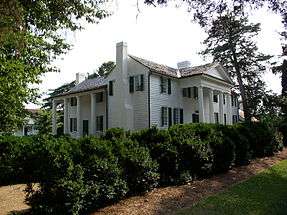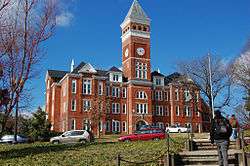Clemson University Historic District II
Not to be confused with Clemson University Historic District I.
|
Clemson University Historic District II | |
 | |
| Location | Center of campus, Clemson, South Carolina |
|---|---|
| Coordinates | 34°40′40″N 82°50′18″W / 34.67778°N 82.83833°WCoordinates: 34°40′40″N 82°50′18″W / 34.67778°N 82.83833°W |
| Area | 15 acres (6.1 ha) |
| Built | 1803–1940 |
| Architect | Rudolph E. Lee |
| Architectural style | Renaissance Revival, Queen Anne, Art Deco |
| MPS | Clemson University MPS |
| NRHP Reference # | 89002139[1] |
| Added to NRHP | January 4, 1990 |
The Clemson University Historic District II is a collection of historic properties on the campus of Clemson University in Clemson, South Carolina. The district contains 7 contributing properties located in the central portion of the campus.[2] It was listed on the National Register of Historic Places in 1990.[1]
Contributing properties
| Building | Photo | Built | Location | Notes |
|---|---|---|---|---|
| John C. Calhoun Office | .jpg) | circa 1825 | 34°40′39.5″N 82°50′20.3″W / 34.677639°N 82.838972°W | John C. Calhoun's office on the premises of his Fort Hill estate served as his private library. Its Greek Revival style echoes that of the main house.[3] |
| Fort Hill |  | circa 1803 | 34°40′40.6″N 82°50′20.2″W / 34.677944°N 82.838944°W | John C. Calhoun purchased the plantation & house in 1825. It was passed to his daughter, Anna, and son-in-law Thomas Green Clemson. Clemson willed the land to the State to be used for a public university. It was individually listed as a National Historic Landmark in 1960.[3] |
| Hardin Hall |  | 1890 | 34°40′41.8″N 82°50′12.9″W / 34.678278°N 82.836917°W | Hardin Hall is the oldest academic building on campus. It was originally built as the Chemistry laboratory, it was expanded in 1900 and 1937, and has housed the Education department and administration offices.[3] It currently houses the departments of History, Philosophy, and Religion. |
| Outdoor Theater |  | 1940 | 34°40′41.7″N 82°50′10.0″W / 34.678250°N 82.836111°W | The Outdoor Theater was built as a gift of the Class of 1915, and designed by one of its members and the university's first architecture graduate, Leon LeGrand. The Art Deco stage was nearly demolished and replaced in 1977, but protests prompted its renovation and the addition of concrete terraced seating.[3] |
| Riggs Hall |  | 1927 | 34°40′37.2″N 82°50′16.4″W / 34.677000°N 82.837889°W | Riggs Hall was built to replace Mechanical Hall, which burned in 1926. It was designed by Architecture department chairman Rudolph E. Lee. The departments of Architecture, Civil Engineering, Electrical Engineering, and Mechanical Engineering were the first tenants. Architecture and Civil Engineering moved into the new Structural Science Building in 1958, but Electrical and Mechanical Engineering are still located in the building.[3] |
| Sirrine Hall |  | 1938 | 34°40′37.4″N 82°50′21.5″W / 34.677056°N 82.839306°W | Sirrine Hall was built to replace Godfrey Hall as the Textile building. It was one of 8 buildings built between 1936 and 1938, and designed by Rudolph E. Lee in an Italian Renaissance Revival style.[3] Today, the building houses the College of Business. |
| Trustee House |  | 1904 | 34°40′42.3″N 82°50′17.1″W / 34.678417°N 82.838083°W | The Trustee House was originally the home of Chemistry department chairman Mark B. Hardin. After his death, the Board of Trustees used it for meetings, and visiting dignitaries stayed in the house.[3] |
See also
References
- 1 2 Staff (2009-03-13). "National Register Information System". National Register of Historic Places. National Park Service.
- ↑ "Clemson University Historic District II". National Register Properties in South Carolina. South Carolina Department of Archives and History. Retrieved 20 May 2011.
- 1 2 3 4 5 6 7 Davis, Martin A.; Edwards, John (31 May 1988). "Clemson University Historic District II". National Register of Historic Places Registration Form. National Park Service. Archived from the original (PDF) on 22 May 2011. Retrieved 22 May 2011.
| |||||||||||||||||||||||||
This article is issued from Wikipedia - version of the Monday, November 30, 2015. The text is available under the Creative Commons Attribution/Share Alike but additional terms may apply for the media files.


